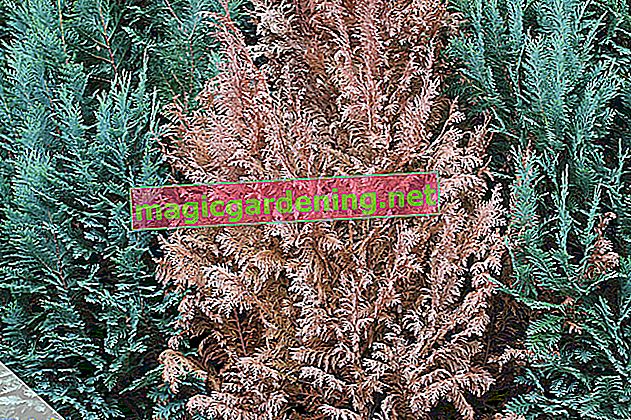
Causes of brown tips of thuja
- Freshly planted thuja hedge
- Sunburn (cutting, location)
- too little poured
- Road salt
- Pest infestation
Often the brown tips appear when you have just planted the hedge. The reason for the discoloration is that the tree initially puts all its strength into root formation and neglects supplying the shoot tips.
also read
- The thuja in the pot turns brown - causes of brown needles
- Thuja turns yellow - the tree of life gets yellow tips
- What to do if thuja emerald turns brown?
Give some organic plant aid that you can get at gardening shops. It strengthens the tree of life so that it gets more strength for the formation of new shoots.
However, you should absolutely avoid over-fertilization, as this is very harmful to the tree of life.
Brown tips from pests
Occasionally there is the leaf miner, which causes brown tips on the thuja hedge. An infestation can be recognized by feeding tunnels in the shoots and excrement deposits on the leaves.
Treatment is only necessary if the infestation is very severe.
Remove brown tips
You can simply cut off the brown tips. Be careful not to cut too much, especially not into the old wood.
Do not prune when the sun is shining strongly or the arborvitae is very wet.
How to prevent brown tips on the tree of life
Make sure you have a good water supply. The soil must always be slightly damp, but waterlogging must be avoided at all costs.
The tree of life does not get road salt. Therefore, do not plant the hedge or tree too close to paths and roads that are sprinkled with road salt in winter.
Very young thuja in particular suffer from strong sunlight. It can be helpful to give them some shade in the midday sun. This is especially true during winter.
Brown buds on the thuja
Brown buds are not a real problem. These are dried up seed heads. You can simply cancel or cut them off.
Tips
If the thuja hedge turns brown from the inside, this is almost always a completely natural process. You usually don't have to undertake anything. Treatment is only necessary if care errors, diseases or pests are responsible.








